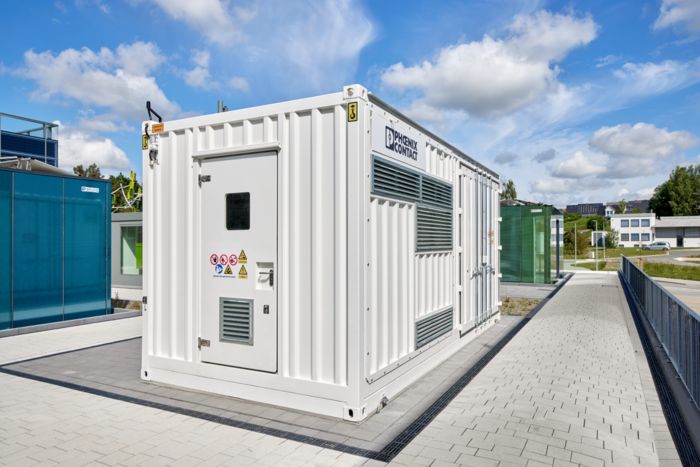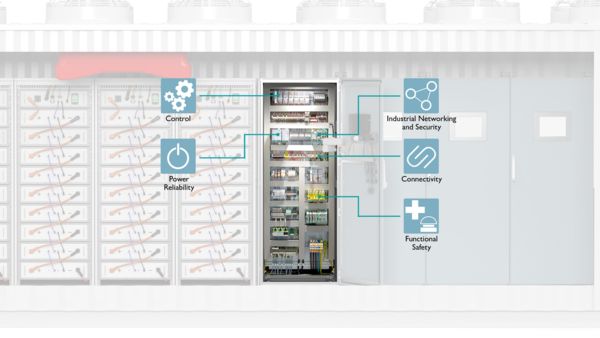The All Electric Society Park – how sector coupling works Flexibility with a battery storage system and energy management.

Brief summary
Industrial companies are increasingly using renewable energies to reduce costs and achieve sustainability targets. The volatility of electricity generation poses a challenge here. An effective energy management system is needed to store surplus energy and use it during peak load times. Otherwise, energy costs will rise.
A good example is the Phoenix Contact All Electric Society Park, which achieves flexibility and efficiency through a central, large-scale battery storage system. This storage system compensates for power peaks and enables the sustainable use of solar power.

Battery storage system in the All Electric Society Park by Phoenix Contact in Blomberg, Germany
Leveraging the full potential
Industrial companies are increasingly turning to renewable energies to reduce costs and achieve sustainability targets. But take note: Sustainability is certainly being improved by using electricity from company-owned photovoltaic systems. However, the volatility of power generation from renewable sources generally runs counter to the needs of continuous industrial processes. The dream of green, clean energy for sustainable, climate-neutral, and efficient production is in danger of being shattered.
Without an effective energy management system, surplus energy cannot be stored in a holistically optimized manner and cannot be used efficiently during peak load times. This can lead to high energy costs. Companies are forced to purchase expensive electricity from the grid when their own power generation is not sufficient. If the flexibility of the energy storage system is not used in a holistically optimized manner, the potential for reducing costs and increasing efficiency often remains untapped, or is at least only partially leveraged.
A look at the Phoenix Contact All Electric Society Park in Blomberg, Germany, helps to illustrate the situation: generating large quantities of its own electricity and being as independent as possible are the most important goals of the All Electric Society Park. And the electricity should come from environmentally friendly sources. A highly optimized and at the same time very flexible energy system is essential for achieving these goals.
Impossible without a battery storage system
The invisible pillar of the desired flexibility is the large-scale central battery storage system. Compared to the colorful design of the Windtree and the chic glass façade of the modern, translucent visitor center, it is rather unspectacular. But the rest would be impossible without it. After all, it makes the energy flows in the All Electric Society Park flexible.
Dipl.-Ing. Holger Krings from Phoenix Contact, helped to plan the energy system of the All Electric Society Park and designed the battery storage system for its use. “In practice, many on-site energy systems offer flexible usage options for surplus solar power. But they are often inadequate. Battery storage systems are usually the best solution when there is not enough flexibility in building operations.”
Demand in the All Electric Society Park is currently 1.2 MWh. The central large-scale battery storage system is housed in an energy storage container and contains 78 battery modules and a central converter. It allows power of up to 1 MVA to be drawn upon, depending on the requirements. This is particularly helpful in compensating for power peaks due to High Power Charging in the neighboring e-mobility charging park, for example.
Another, smaller battery storage system with a capacity of 225 kVA located right in the charging park supplements the storage system and primarily functions as a power booster. Conversely, the storage system can be charged with the surplus energy generated from the PV system and make it available later. In total, the two storage systems have a capacity of up to 1.5 MWh. This increases the sustainable use of electricity generated from renewable sources and greatly expands the scope for efficient energy management.

Battery storage systems include a wide range of components in different categories
The advantages of load management
Leveraging dynamic electricity tariffs
Battery storage systems can be used to charge with electricity from the grid when electricity tariffs are favorable. This energy can then be used when the tariffs are high. This is not necessarily linked to the goal of sustainability, but can be economically interesting. If the price difference is high enough, the purchase of a battery system alone may be worthwhile.
Reducing peak loads (peak shaving)
To avoid high costs due to sudden high power consumption from peak loads, it makes sense to monitor the power consumption at the grid connection point. This applies to grid connections with registering consumption metering, which is the norm for industrial companies and many commercial enterprises. Here, the battery storage system can help to keep the power output of each quarter-hour interval within the agreed limits.
“Boost” power for local consumption peaks
The provision of “boost” power is similar to peak shaving. It primarily compensates for locally inadequate infrastructure capacity. At the same time, it helps to prevent potentially costly power peaks at the grid connection, i.e., it also has a peak shaving effect. This is often what makes HPC charging infrastructure possible in the first place, since the existing infrastructure is often not adequately dimensioned.
Providing control power for the public grid
Although associated with significantly higher regulatory requirements, participation in the control power market can also be interesting for large-scale battery storage systems. On the other hand, this basically excludes simultaneous in-house use for other purposes.
Smoothing power peaks
With the battery storage system at the All Electric Society Park in Blomberg, power peaks can be offset systematically. They potentially help to save around €200,000 per year. A lower power limit could also be agreed with the grid operator at the transfer point to the public grid. Unplanned power peaks have become significantly more expensive over the years. Up to 200 €/kW peak power is not uncommon. Depending on the cause, this amount would be charged, for example, in case of an unplanned peak power of 1 MVA.
Or imagine a visitor charging their electric car for 15 minutes at 50 kW when the contractual power limit has already been reached or exceeded. This operation would cost €10,000, but this could not reasonably be passed on to the visitor.
In summary, it can be said that a central battery storage system helps to save costs and make operations more sustainable. It is important for the battery storage system to be correctly dimensioned. Charging and discharging performances depend on the capacity. At best, the system is modularly extendable and can be adapted to future energy and power requirements. An independent energy management system is essential for making optimum use of the flexibility of the storage system and for optimizing the energy system as a whole.
Connect with our experts

More posts

Battery storage system as a functional booster
Phoenix Contact uses open control technology to close the gap between power generation, storage, and further use.

Energy storage systems connect sectors
The importance of innovative connection technology for the safe operation of energy storage systems and for the realization of the All Electric Society.

Integral building planning
How integral building planning and digitalization are revolutionizing building construction.



